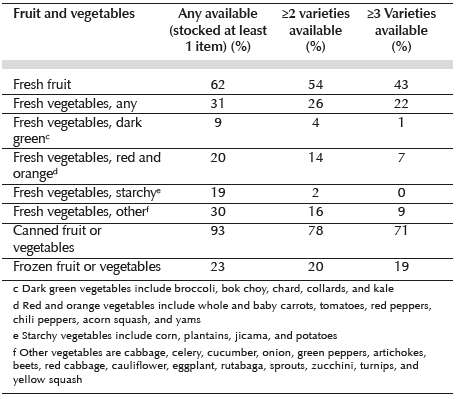Limited availability of healthy foods in small- to mid-sized SNAP-authorized food retailers
Better access to supermarkets and healthy foods is commonly associated with healthy diets and reduced risk of obesity. However, in the U.S., supermarkets tend to be located in higherincome and lower-minority areas. Thus individuals living in lowerincome communities are more likely to buy food in convenience stores with limited supply of healthy foods, which could lead to an increase of health risks.
Improving access to healthy foods
In the U.S., the Supplemental Nutrition Assistance Program (SNAP) provides monthly nutrition assistance to 42 million lowincome Americans. In exploring potential ways to improve diet quality among participants, the program has primarily focused on consumer-level approaches such as consumer education and providing incentives for healthy purchases.
Dietary quality among SNAP participants may be improved by increasing access to healthy food, especially in small-size to midsized food stores. The US Department of Agriculture has already established stocking criteria for healthy foods among SNAP – authorized retailers, but these criteria are minimal and mandate very little in the way of healthy foods, such as F&V.
The objective of this study was to quantify healthy foods stocked in small-size to mid-sized food retailers in the U.S. who are authorized under SNAP but not under the Special Supplemental Nutrition Program for Women, Infants, and Children (WIC) (which mandates more extensive stocking of healthy products).
Study design
Store audits were conducted in 2014 in 91 randomly selected, licensed food stores in Minneapolis and St. Paul, Minnesota excluding supermarkets and retailers participating in WIC. The store audit was based on a tool developed at the Yale Rudd Center for Food Policy and Obesity to evaluate the impact of 2009 WIC policy revisions in small stores.
The availability of milk, F&V, and whole-grain-rich foods was assessed. The audit measured availability of 69 specific items and the quality of 20 designated fruit and vegetables. Quality of 20 common types of fruit and vegetables was rated (A, A-, B, B-, C; A being the best) depending on the condition of the product: molded, wrinkled, shriveled, bruised, and wilted.
Food supply in SNAP-participating stores
Most SNAP participating stores in the sample were food-gas marts (43%); corner stores or small groceries (34%); dollar stores (10%); pharmacies (13%). Most of them offered canned fruit or vegetables (93%), whole-grain-rich cereal (80%), fat-free or low-fat milk products (64%) or fresh fruit (62%). Less than one-third of stores (31%) stocked fresh vegetables, with fewer stocking nutrient-rich varieties, like red and orange vegetables (20%) or dark green vegetables (9%). Frozen fruit or vegetables were carried approximatively by 1 in 4 stores. Table 1 shows the percentage of F&V availability and the number of varieties carried by the stores.
Table 1: Availability of F&V in study sample of small-size to mid-sized food stores (N=91) participating in SNAP; Minneapolis and St. Paul, Minnesota, USA, 2014

Most stores received scores of A or A- for all the fresh fruit (58% of stores) or vegetables (62%) they carried, and few scores received poor ratings. The most commonly stocked fruit were bananas, apples, oranges, limes, and lemons, and the most common vegetables were onions, tomatoes, potatoes, celery, and lettuce.
A lack of healthy food in small to mid-size retailers
This study showed that a large number of small-size to midsized food stores did not carry a variety of healthy items, especially fresh or frozen vegetables or whole-grain-rich foods (bread, tortillas, brown rice). Only varieties of canned fruit and vegetables and whole-grain-rich cereals were widely available.
USDA should require SNAP-authorized retailers to carry greater minimum quantities of specific healthy foods, including fruit and vegetables (such as dark green, red and orange vegetables) and whole-grain-rich foods. An increase in stocking standards for retailers could be a part of the solution to address health-related disparities. USDA should also consider the implementation of adequate infrastructure (such as refrigerators or coolers) to stock a minimum supply of perishable products. Furthermore, owners and their staff may need training on produce handling, storage and merchandizing to offer a wide range of high quality products.
In February 2016, USDA proposed enhanced retailer standards for SNAP-participating retailers, as mandated by Congress, but these proposed enhancements fall well below recommended standards. For example, the Robert Wood Johnson foundation recently convened an expert panel to develop standards and write a report on, “Minimum Stocking Levels and Marketing Strategies of Healthy Foods for Small Food Stores,” which details much higher standards and can be found here:
http://healthyeatingresearch.org/wp-content/uploads/2016/02/her_minimum_stocking_final.pdf. The proposed rule from USDA was open for comment until April 18th, 2016:
https://www.federalregister.gov/articles/2016/02/17/2016-03006/enhancingretailer-standards-in-the-supplemental-nutrition-assistance-program-snap.
